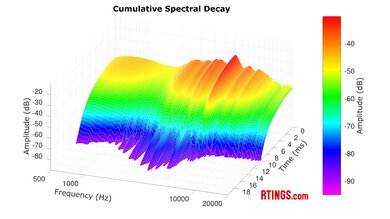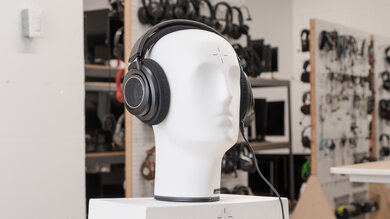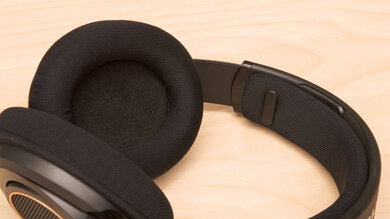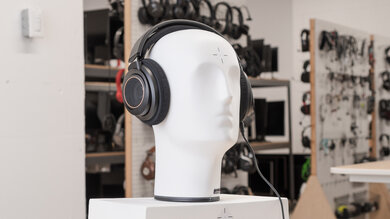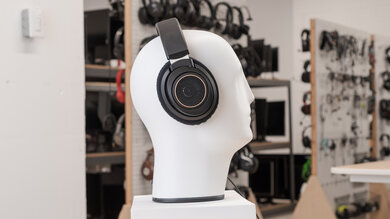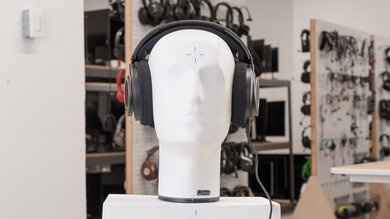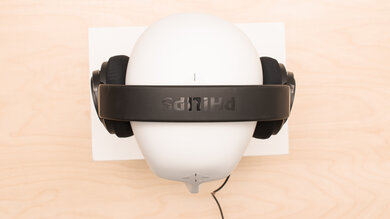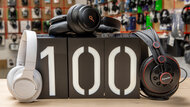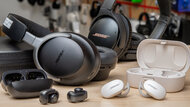The Philips SHP9600 are lightweight and reasonably budget-friendly wired-only open-back headphones designed for casual listening. They perform very similarly to their predecessor, the Philips SHP9500, but they have a slightly sleeker look and a boomier bass. Overall, they're tuned to suit a variety of music genres and media consumption, like podcasts and games. That said, due to their open-back design, they leak a lot of sound and don't isolate a lot of ambient noise, so they aren't ideal for outdoor use.
Our Verdict
The Philips SHP9600 are sub-par for sports and fitness. As headphones designed for casual and seated sessions, this isn't surprising. They're not stable enough to stay put for most exercises, and their long cable can catch on gym equipment. As bulky over-ear headphones, they're not portable either, though they feel comfortable and supply a good amount of boom on bassy frequencies.
- Comfortable fit.
- Balanced sound profile.
- Not stable enough for exercise.
- Not very portable.
A bit plasticky in build.
- Terrible noise isolation performance.
- Leaks a lot of noise.
The Philips SHP9600 are poor for travel. They're bulky open-back headphones that fit over-ears, so they leak plenty of audio into your space and don't meaningfully block out any ambient noise either. They're comfortable to wear for extended sessions, but they're otherwise rather impractical with a long, cumbersome cable, and they take up a lot of space in your bag.
- Comfortable fit.
- Balanced sound profile.
- Not very portable.
A bit plasticky in build.
- Terrible noise isolation performance.
- Leaks a lot of noise.
The Philips SHP9600 are poor for office work. Unless your office has a door, these open-backs leak a lot of your audio into the space, which will disturb co-workers. Meanwhile, they won't prevent the sounds of your office from reaching your ears either, which is distracting. Since they lack an in-line microphone, you'll also need an outboard mic for online meetings, too. That said, they feel light and very comfortable for long periods, and they produce a clear and mostly balanced sound.
- Comfortable fit.
- Balanced sound profile.
- No microphone.
- Terrible noise isolation performance.
- Leaks a lot of noise.
The Philips SHP9600 are wired-only, so they can't connect wirelessly for gaming.
The Philips SHP9600 are passable for wired gaming. They don't have a microphone, so if you need to chat with other players, you'll need an outboard mic. Otherwise, these feel very comfortable and lightweight for extending gaming sessions. They also yield a stable stereo image, so you can locate objects within the stereo field. Their PRTF can sound a bit artificially wide in how they interact with your outer ears. Their sound profile is balanced but not very rumbly in the low bass, though sounds like footsteps come through clearly, and dialogue is intelligible, but the top-end's dull low-treble can hurt articulation a little. That said, despite their comfort, these aren't the most durable headphones, and they're a bit plasticky.
- Comfortable fit.
- Balanced sound profile.
- No microphone.
A bit plasticky in build.
The Philips SHP9600 are decent for audio reproduction accuracy. Their balanced sound profile delivers a somewhat mid-forward tuning with ample boom and mostly clear treble that mostly follows our target, except in the bass. They're not very thumpy in the lower registers (like most open-backs), but kick drums playback with a solid punch. Voices and leads sound mostly natural with a bit of de-emphasis in the high-mids and low-treble, which can dull the presence a bit, while cymbals still sound bright. The L/R drivers create a stable stereo image, and their peaks and dips create an overall smooth sound. On the other hand, their PRTF can cause sounds to seem a bit artificially wide. The group delay is also sub-par and can cause bass frequencies to sound somewhat undefined, but since these are rolled off anyway, it's not very bothersome.
The Philips SHP9600 are open-back headphones, so their noise isolation is awful by design. As a result, they let environmental noises reach your ears essentially unimpeded. They also allow a lot of your audio to escape, which is audible to people nearby.
The Philips SHP9600 don't have a microphone.
The Philips SHP9600 are good for frequency response consistency. Their over-ear seal is similar over the course of repeated wears and provide a consistent sound. There's some minor low-bass variation for folks with long hair or who wear glasses, but it's not significant.
Performance Usages
Changelog
- Updated Jul 17, 2025:
This review has been updated to Test Bench 2.0, which adds the following tests: Stereo Mismatch, Group Delay, Cumulative Spectral Decay, PRTF, Harmonic Distortion, and Electrical Aspects. In addition, we've added updated results for Isolation, including Noise Isolation - Full Range and Noise Isolation - Common Scenarios. We've added new performance usages and updated the text throughout the introduction, comparisons, and Sound tests and side-by-sides.
- Updated Jul 10, 2025: We've converted this review to Test Bench 2.0, which updates our sound tests and adds performance usages. You can read more about this in our changelog.
- Updated Jul 04, 2025: We've converted this review to Test Bench 1.8, which updates our target curve and Sound tests. You can read more about this in our changelog.
- Updated Jun 27, 2025: We've converted this review to Test Bench 1.7, which updates our Noise Isolation test. We've also expanded the scope of this test to include Common Scenarios in addition to Voice Handling and Wind Handling.
Check Price
Differences Between Sizes And Variants
The Philips SHP9600 only come in one color, 'Black.' You can see the label. If you come across another variant, let us know in the comments.
Popular Headphones Comparisons
The Philips SHP9600 perform similarly to the Philips SHP9500 but have a more extended bass. Both have open-back designs, and their sound profiles suit lots of different music genres. The SHP9500 have a flatter bass and mid-range, while the SHP9600 sound boomier to offset the expected roll-off in the low bass that comes with most open-backs. Other open-back headphones that roughly boost the high bass like the SHP9600 for casual use include cans like the Sennheiser HD 599, but the SHP9600 tend to undercut the Sennheiser headphones in price tier. However, like most open-backs, all of these headphones aren't very versatile outside of listening at home due to the open-back design, which doesn't isolate you or ensure your audio remains private.
If you're looking for other headphones, check out our recommendations for the best open-back headphones, the best headphones for audiophiles, and the best headphones for music.
The Philips SHP9600 are very similar performing open-back headphones to the Philips SHP9500. The SHP9600 have a sleeker, all-black design and leak less audio. Both headphones have very balanced sound profiles that suit a wide range of music genres, though the SHP9500 comply most closely with our target curve with a flatter bass. For greater boom on the bass, the SHP9600 tend to provide more punch on kicks.
Both the Sennheiser HD 599 and the Philips SHP9600 are open-back, comfortable headphones with long detachable cables and tuned for casual use. Depending on your priorities, you might prefer one or the other. The Sennheiser have a more stable fit and better build quality. The Philips keep costs down with a cheaper and more plasticky build, but they're well-matched with a consistent frequency response, so you might prefer them for their value.
The Philips Fidelio X2HR are better headphones for neutral sound than the Philips SHP9600. While both pairs of open-back headphones have balanced sound profiles, the Fidelio X2HR have a flatter sound in the bass and mids. They're also better built. Some listeners may prefer the extra boom and punch in the SHP9600's bass range. The SHP9600 also have a more comfortable fit.
The Sennheiser HD 560S are slightly better than the Philips SHP9600, though they both feel very comfortable and are open-back over-ears. The Sennheiser have a flatter sound signature with better bass extension and they're a bit clearer and brighter. Plus, they're a little better matched in the L/R and have tighter bass definition due to their group delay. However, the Philips offer a thicker high bass and low-mid emphasis, so if you prefer a more mid-forward tuning, these might suit you better. They also tend to land in a more budget-friendly tier.
Test Results

The Philips SHP9600 have a broadly balanced, slightly warm low-treble and brighter upper treble sound profile. Like most open-back headphones, they struggle to reproduce low bass, which may be disappointing for fans of bass-heavy genres like EDM. They pack an extra boom and punch to help compensate, however. Overall, they're suitable for listening to a range of music genres with a mid-forward tuning.
These headphones have good frequency response consistency. They sound nearly the same across different listeners and reseat each time you use them, although there may be some inconsistencies in the bass range depending on their fit, seal, and positioning on your head. If you wear glasses or have long hair, it can influence how the low bass sounds somewhat.
These headphones have adequate bass profile target compliance. Like most open-backs, they struggle to reproduce low bass, so you don't feel the deep thump of instruments like kick drums. However, they boost mid and high bass to add an extra punch and boom to the mix, though it may sound slightly bloated on busy tracks.
These headphones have good mid-range target compliance. The response tilts to emphasize the low-mids, so vocals and lead instruments sound full-bodied and present. However, the underemphasis in the high-mid weakens these same instruments, so they sound a bit distant in the higher mids.
These headphones have very good treble profile target compliance. The response is mostly flat and even, so voices and sibilants like cymbals are bright and brilliant. There's underemphasis in the low-treble, however, which can hurt the comprehensibility of vocals and lead instruments. A narrow band of emphasis in the mid-treble can cause some harmonics of cymbal hits to come across as piercing, though.
These headphones have very good peaks and dips performance. They're lacking a bit of low bass, but it's overall smooth in the low-end for a fairly even punch on kicks. The dip in the high-mid makes vocals and lead instruments sound weak and distant, while the rest of the mid-range sounds clear. The narrow peak in the mid-treble can make some sibilants a bit piercing, while the surrounding dips make harmonics sound a bit dull.
These headphones demonstrate great stereo mismatch results. The L/R drivers are tightly matched in weighted amplitude, so each side sounds balanced in volume. There's some frequency response mismatch, but it's mainly in the treble, slightly tilting select frequencies to the right side, though it's not very significant. Similarly, there's a phase mismatch in the bass and treble, though these fall below the audibility threshold. This can vary between different pairs of the same headphones, so these results only apply to our unit.
The Philips SHP9600 have poor group delay. Since these headphones roll off low bass, the delayed timing of the low-bass frequencies doesn't affect the bass definition as much as the graph suggests. However, it still skirts the audibility threshold in the high bass, so the boom and punch of bass can sound a little flubby. Still, the mids and treble sound tight and transparent.
The Philips SHP9600 open-back over-ears have a middling PRTF performance. They interact with the pinna, or the outer ear, though this doesn't mimic the effect of listening to an angled reference monitor. That said, the outer ear interaction can come across as a bit artificially wide.
These exhibit excellent harmonic distortion. When pushed to 94 and 104 dB/SPL, the percentages are low overall across the frequencies tested. There's some distortion in the bass at 104 dB, but since these headphones don't reproduce much low bass anyway, it's not perceptible. As a result, your signal remains clean-sounding.
These headphones don't require a headphone amp to drive them with most audio sources.
These are the settings we used to test these headphones. Our results are only valid with these test settings.
The Philips SHP9600 have a simple, all-black design. They look very similar to the Philips SHP9500, but the side panels on these headphones are plain, giving them a slightly sleeker look. The headband and the ear cups are well-padded.
The Philips SHP9600 are decently well-built headphones. Like the Philips SHP9500, they feel a bit plasticky, but overall their build seems quite stable and durable. The thin metal frame that reinforces the headband helps make it more sturdy. However, the fabric padding seems like it could tear easily, and the swiveling ear cups seem like a weak point. For open-back headphones with a better build quality, see the Philips Fidelio X3.
The Philips SHP9600 have a terrible noise isolation performance. Due to their open-back design, they don't isolate against noise in the bass and mid-range, so you can hear background voices and sounds like bus and plane engines. They perform a bit better in the treble range, but you may still be able to hear higher frequency noises like computer fan whine.
Like most open-backs, these leave your ears open to hearing all the ambient noise of your environment. Office keyboard clatter, fellow passengers talking on transit, and rumble from buses and subway trains all reach your ears.
These headphones have an awful leakage performance, which is typical of open-backs. They leak a lot of noise, especially in the mid and treble ranges, and the leakage is loud and comprehensible.
These headphones can be plugged into your PS controller's headphone output. However, if you want to chat with your team, you'll need your own mic.
You can connect these headphones to your Xbox controller, but they don't have a microphone, so you can only hear audio.

